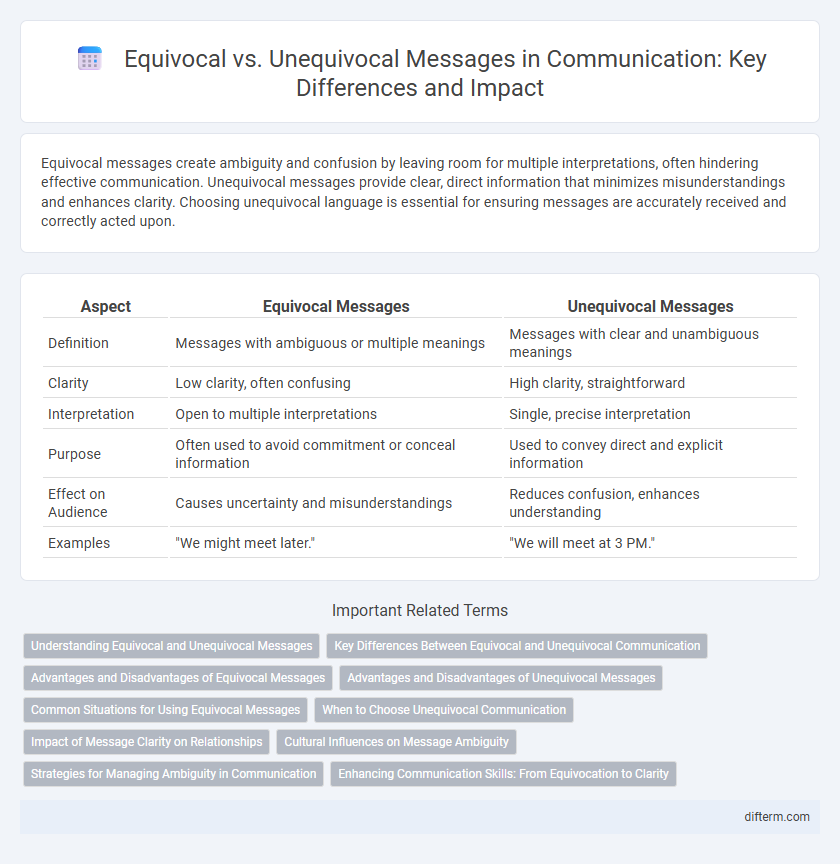Equivocal messages create ambiguity and confusion by leaving room for multiple interpretations, often hindering effective communication. Unequivocal messages provide clear, direct information that minimizes misunderstandings and enhances clarity. Choosing unequivocal language is essential for ensuring messages are accurately received and correctly acted upon.
Table of Comparison
| Aspect | Equivocal Messages | Unequivocal Messages |
|---|---|---|
| Definition | Messages with ambiguous or multiple meanings | Messages with clear and unambiguous meanings |
| Clarity | Low clarity, often confusing | High clarity, straightforward |
| Interpretation | Open to multiple interpretations | Single, precise interpretation |
| Purpose | Often used to avoid commitment or conceal information | Used to convey direct and explicit information |
| Effect on Audience | Causes uncertainty and misunderstandings | Reduces confusion, enhances understanding |
| Examples | "We might meet later." | "We will meet at 3 PM." |
Understanding Equivocal and Unequivocal Messages
Equivocal messages contain ambiguous or unclear information, often leading to multiple interpretations and potential misunderstandings in communication. Unequivocal messages deliver clear, direct, and unambiguous content that minimizes confusion and enhances message clarity. Understanding the distinction between equivocal and unequivocal messages is essential for effective communication, as it ensures receivers accurately interpret the intended meaning.
Key Differences Between Equivocal and Unequivocal Communication
Equivocal messages contain ambiguous language that allows multiple interpretations, often leading to confusion or misunderstanding in communication. Unequivocal messages use clear, direct language, ensuring the intended meaning is explicit and easily understood by all parties. Key differences lie in the predictability of responses and the level of clarity, with unequivocal communication fostering trust and reducing misinterpretation.
Advantages and Disadvantages of Equivocal Messages
Equivocal messages offer the advantage of flexibility, allowing speakers to navigate sensitive topics or avoid conflict by leaving interpretations open-ended. However, this ambiguity can lead to misunderstandings, reduced clarity, and potential mistrust in communication exchanges. Over-reliance on equivocal messages may hinder effective decision-making and damage relationships due to a lack of directness.
Advantages and Disadvantages of Unequivocal Messages
Unequivocal messages provide clarity and reduce misunderstandings by conveying precise and direct information, enhancing effective communication in professional and personal contexts. Their main advantage lies in minimizing ambiguity, which helps to streamline decision-making processes and build trust between parties. However, the disadvantage is that they may come across as overly rigid or insensitive in situations requiring diplomacy or nuanced feedback.
Common Situations for Using Equivocal Messages
Equivocal messages frequently arise in workplace meetings where sensitive topics require diplomacy to avoid conflict or misinterpretation. In social interactions, equivocal language helps maintain politeness when individuals want to express disagreement without offending others. These messages also appear in marketing communications to generate curiosity and engagement while preventing overcommitment or misinterpretation of product details.
When to Choose Unequivocal Communication
Unequivocal communication is essential in high-stakes situations such as emergency responses, legal agreements, or technical instructions where clarity and precision prevent misunderstandings. Selecting unequivocal messages ensures that the receiver interprets the information exactly as intended, reducing ambiguity and the risk of errors. This communication style is particularly critical in environments requiring strict compliance with protocols and where decisions depend on accurate, unambiguous information.
Impact of Message Clarity on Relationships
Equivocal messages create ambiguity that often leads to misunderstandings and erodes trust in relationships, causing confusion and emotional distance between parties. Unequivocal messages enhance clarity, fostering open communication and strengthening relational bonds through transparency and mutual understanding. Clear messaging supports effective conflict resolution and builds a foundation of reliability and respect in personal and professional interactions.
Cultural Influences on Message Ambiguity
Equivocal messages often arise from cultural differences in communication styles, where high-context cultures rely on indirect language and nonverbal cues, increasing message ambiguity. In contrast, low-context cultures favor unequivocal messages with explicit and clear language, minimizing misunderstanding. Understanding these cultural influences is essential for effective cross-cultural communication and reducing ambiguity in global interactions.
Strategies for Managing Ambiguity in Communication
Equivocal messages contain multiple interpretations that create ambiguity, whereas unequivocal messages are clear and precise, reducing misunderstanding. Strategies for managing ambiguity in communication include seeking clarification through targeted questions, providing context to narrow down possible meanings, and using explicit language to minimize misinterpretation. Employing feedback loops, such as paraphrasing and active listening, strengthens message clarity and ensures mutual understanding in both verbal and written exchanges.
Enhancing Communication Skills: From Equivocation to Clarity
Equivocal messages often lead to misunderstandings and confusion, hindering effective communication and collaboration. Clear, unequivocal messages enhance transparency, foster trust, and improve interpersonal interactions by reducing ambiguity. Mastering the art of delivering precise, unambiguous communication is essential for professional and personal success.
equivocal messages vs unequivocal messages Infographic

 difterm.com
difterm.com